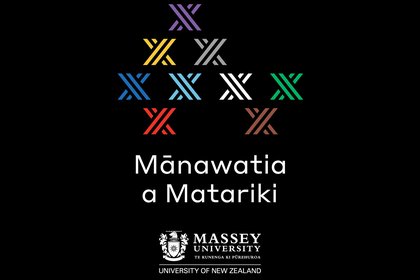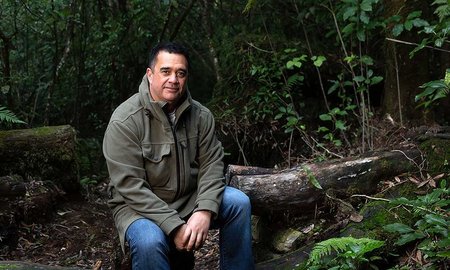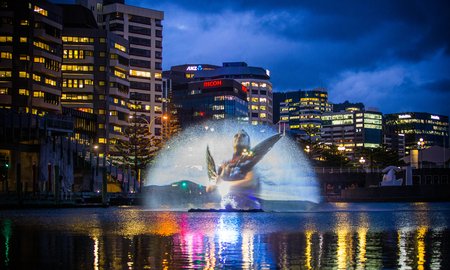
The link between astronomy and the natural cycle of the environment is an important foundation of te ao Māori, with this knowledge being passed down through generations. Many seasonal activities and customs are guided by this astronomical knowledge, and so the arrival of the star cluster Matariki signifies a time for gathering to reflect on what the year has given us, remember those who have passed, and to prepare for the coming year.
This year, the official day of celebration is Friday 24 June and is the first year Aotearoa is celebrating Matariki as a nation. The celebration is based around three major principles:
- remembrance to honour those who have passed since the last rising of Matariki,
- celebrating the present to give thanks for the year’s blessings and to reconnect with loved ones,
- looking to the future by coming together to plan for the year ahead.
There are two modern themes connected to the new Matariki holiday. The first is Matariki hunga nui, which stands for Matariki who gathers people together. It is a significant hope for the newly established holiday that Matariki will be a guiding call that brings people home to their loved ones, and encourages people to honour and return not only to one’s whānau, but their identity.
A connection to the environment is an intrinsic part of Matariki, and the second theme is centred around how the celebration can reaffirm our connection and commitment to the environment. It is a time to consider our responsibility to the environment, and the sustainable practices we currently uphold, and those practices we need to improve upon moving forward.
The following resources offer insight into the important relationships between Matariki, kaitiakitanga, and climate change: Are we using the word kaitiaki appropriately?, Māori and climate change, defining kaitiakitanga, and kaitiakitanga in urban restoration.
Ways you can support kaitiakitanga while celebrating Matariki:
- Reflect on past events and set new intentions for the future – What can you do to support kaitiakitanga in your everyday life over the next year?
- Learn about each start of the Matariki cluster – what actions can you take to protect the realms of each star – e.g. water activities, land activities, weather monitoring, health and well-being related activities
- Connect to your local environment – How can you support the efforts of local Kaitiaki in your area? What are the important stories of your local area?
- Attend events in your area – What knowledge can you learn that will help to connect you to your local area – e.g. hapū of the area, sites of significance, relationships between hapū, important biodiversity in your area.
- Sharing kai with whānau and friends – What local foods can you contribute/ share with whānau, what are the stories of these local foods?
- Develop your own whānau celebration – what can you do each year to celebrate this time – e.g. tree planting trees, Hautapu, stargazing, planning.
It is important to acknowledge that while all iwi celebrate the Māori New Year, to some iwi around the motu, this celebration is known as Puanga rather than Matariki. This is due to some iwi being unable to see Matariki clearly from their location, and so they look to Puanga, another important star.
We have gathered a range of important resources and events that can help you observe and celebrate the holiday, as well as develop a deeper understanding around the principles and values that underpin Matariki.
Resources and activities:
- Living by the stars: Matariki has nine visible stars that each hold significance and play an important role in the celebration of Matariki. Professor Rangi Matamua, Tūhoe, has spent more than 20 years researching Matariki and revolutionising understandings of Māori astronomy with his website containing a wealth of resources, including a seminar that offers an in-depth look into Matariki. He has also featured on a podcast discussing Matariki and Māori astronomy and has a Facebook where he shares his knowledge.
- Te Papa Tongarewa: Te Papa has a fantastic range of resources and activities to explore, including tips on how to celebrate Matariki at home, a video on how to find the Matariki star cluster, a Matariki activity book for tamariki, resources for making memory keepsakes, and even a quiz to test your Matariki knowledge.
- Te Wānanga o Aotearoa: Along with a downloadable Matariki handbook, this website provides a further look into the three major principles underpinning traditional Matariki celebrations and provides activity resources and a database to search for Matariki events taking place in your area.
- Matariki - Te Ara Encyclopedia of New Zealand provides a great overview of Matariki.
- E Mātai Nei I Ngā Whetū: A kōrero with Dr Rangi Matamua.
- The latest Getting Through Together – Whāia E Tātou Te Pae Tawhiti campaign has a list of ways to celebrate Matariki at home, with your whānau and your workplace, and encourage the celebration of Matariki to others.
- Hamilton City Libraries have created a list of books and multimedia for children and adults to read more about the history and celebration of Matariki.
- Spending time with loved ones is important for Matariki, and part of that time together can be spend making crafts or playing traditional Māori games. Whetū or stars are a significant symbol of Matariki and there’s a range of fun ways to incorporate them into crafting activities including weaving whetū or making bunting. Manu tukutuku, kites, also host significance as they were traditionally used to welcome Matariki as they sailed close to the whetū and connect us to those who have passed. Try making a manu tukutuku to fly on Matariki.
Events:
General:
- What’s happening around Aotearoa for Matariki in 2022
- Matariki Events
- Online talk 21 June: Matariki and our understandings of climate and environmental change
Tāmaki Makaurau:
Manawatū:
Te Whanganui a Tara:
Related news
Meet the man behind Matariki celebrations: Professor Rangi Mātāmua
There are few people whose decisions can influence and impact the daily lives of all New Zealanders, and renowned Māori scholar Professor Rangi Mātāmua, Tūhoe, is one of them: he is responsible for leading the formation of the country’s newest public holiday, Matariki on 24 June.

Mana Moana art experience addresses climate change and greenhouse gas emissions
Mana Moana, the artist-led collaboration between Māori and Pacific visual artists, musicians, writers, and choreographers, is screening two different programmes across two cities for Matariki this year.
